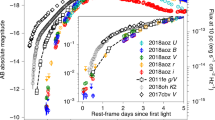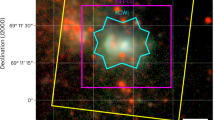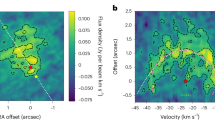Abstract
Strong absorption lines due to Bi II have been found in the Hg—Mn star HR7775 (HD193452) in high-resolution spectra obtained with the IUE. HR7775 was first recognized as a chemically peculiar star by Preston in 1972. Detailed examination of the optical spectrum at high resolution1 showed that it is one of the most extreme stars of the ‘cool’ Hg—Mn group, with strong enhancements of Hg, Pt, Sr, Y, and Ga; the last of these is confirmed2 by the very strong Ga II resonance line at 1,414 Å. Four-colour Strömgren photometry of HR7775 (ref. 3), interpreted with the aid of the model atmosphere calibrations by Relyea and Kurucz4, gives Teff = 10,800 K, log g = 4.2, while the Hβ index gives log g = 4.0 according to the calibration of Schmidt5. We have adopted a fully blanketed model atmosphere6 with solar composition, Teff = 11,000 K, log g = 4.0. Uncertainties in the exact composition and parameters have a very small effect on our results when compared with uncertainties due to oscillator strengths, identification of blending lines, and correct placement of the unblanketed continuum. The overabundance of Bi obtained from spectrum synthesis calculations is ∼106. Close examination of the spectra of several other Hg—Mn stars shows that Bi II is not detected in any other star in this group.
This is a preview of subscription content, access via your institution
Access options
Subscribe to this journal
Receive 51 print issues and online access
$199.00 per year
only $3.90 per issue
Buy this article
- Purchase on Springer Link
- Instant access to full article PDF
Prices may be subject to local taxes which are calculated during checkout
Similar content being viewed by others
References
Dworetsky, M. M. IAU Colloq. No. 32, 549–553 (1976).
Jacobs, J. M. & Dworetsky, M. M. in 23rd Liège Astrophys. Colloq., 153–158, Univ. Liège (1981).
Hauck, B. & Mermilliod, M. Astr. Astrophys. Suppl. 40, 1–32 (1980).
Relyea, L. J. & Kurucz, R. L. Astrophys. J. Suppl. 37, 45–69 (1978).
Schmidt, E. G. Astr. J. 84, 1739–1742 (1979).
Kurucz, R. L. Astrophys. J. Suppl. 40, 1–340 (1979).
Crawford, M. F. & McLay, A. B. Proc. R. Soc. A143, 540–557 (1934).
Moore, C. E. Atomic Energy Levels Vol. 3 (U.S. National Bureau of Standards Circ. No. 467, 1958).
Gruzdev, P. F. Opt. Spectrosc. 25, 1–5 (1968).
Ross, J. E. & Aller, L. H. Science 191, 1223–1229 (1976).
Dworetsky, M. M. thesis, Univ. California, Los Angeles (1971).
Michaud, G. in 23rd Liège Astrophys. Colloq., 355–363, Univ. de Liège (1981).
Dworetsky, M. M. Mon. Not. R. astr. Soc. 191, 521–532 (1980).
Dworetsky, M. M. Publ. astr. Soc. Pacif. 84, 254–259 (1972).
Nariai, K. Publ. astr. Soc. Japan 22, 113–118 (1970).
Guthrie, B. N. G. & Napier, W. M. Nature 284, 536–537 (1980).
Author information
Authors and Affiliations
Rights and permissions
About this article
Cite this article
Jacobs, J., Dworetsky, M. Bismuth abundance anomaly in a Hg—Mn star. Nature 299, 535–536 (1982). https://doi.org/10.1038/299535a0
Received:
Accepted:
Issue Date:
DOI: https://doi.org/10.1038/299535a0
Comments
By submitting a comment you agree to abide by our Terms and Community Guidelines. If you find something abusive or that does not comply with our terms or guidelines please flag it as inappropriate.



